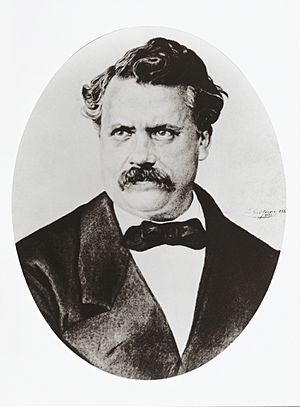Louis Vuitton (designer) facts for kids
Quick facts for kids
Louis Vuitton
|
|
|---|---|
 |
|
| Born | 4 August 1821 Anchay, Jura, France
|
| Died | 27 February 1892 (aged 70) Asnières-sur-Seine, France
|
| Occupation | Malletier |
| Known for | The founder of Louis Vuitton |
| Spouse(s) | Clemence-Emilie Parriaux |
| Children | Georges Ferréol Vuitton |
Louis Vuitton (born August 4, 1821 – died February 27, 1892) was a famous French fashion designer and a smart businessman. He started the well-known Louis Vuitton brand. This company makes fancy leather goods like bags and luggage. Before starting his own brand, he was a special trunk-maker for Empress Eugénie de Montijo. She was the wife of Napoleon III, the emperor of France.
Contents
Louis Vuitton's Early Life
Louis Vuitton was born into a family of skilled workers. His family included carpenters and farmers. When he was 10, his mother, who made hats, passed away. His father also died soon after.
Louis had a tough time with his stepmother. So, at age 13, in the spring of 1835, he left his home in Anchay, Franche-Comté. He walked about 292 miles (470 km) all the way to Paris.
Becoming a Trunk Maker
Louis arrived in Paris in 1837. This was during the Industrial Revolution, a time of big changes. He became an apprentice to Monsieur Marechal. Marechal was a very successful trunk maker and packer.
An apprentice learns a trade by working for a skilled person. Within a few years, Louis became very good at his craft. He was known among the fashionable people in Paris. They saw him as one of the best trunk makers in the city.
Working for the Empress
After the French Empire was set up again under Napoleon III, Louis got a special job. He was hired as the personal trunk maker for the Empress of The French.
The Empress asked him to "pack the most beautiful clothes in an exquisite way." This important job opened doors for Louis. He started getting work from other rich and royal clients. These clients kept him busy for the rest of his career.
Starting His Own Business
In 1854, when Louis was 33, he married Clemence-Emilie Parriaux. Soon after, he left Marechal's shop. He decided to open his own workshop in Paris.
Outside his new shop, he put up a sign. It said: "Securely packs the most fragile objects. Specializing in packing fashions." This showed what he was good at.
New Trunk Designs
In 1858, Louis got an idea from a company in London called H.J. Cave & Sons. He introduced a new kind of trunk. His trunks were rectangular and made of canvas.
At that time, most trunks were rounded on top and made of leather. Louis's new flat-top design was revolutionary. It was durable, meaning it lasted a long time. It was also lightweight, making it easier to carry.
People loved his new designs. The demand for his trunks grew very fast. This led him to open a bigger workshop in Asnières-sur-Seine. The first pattern on his canvas trunks was called "Damier."
The Pick-Proof Lock
Louis Vuitton also created the world's first lock that was very hard to pick. This meant it was very secure. All the designs for these special locks were kept safe at his workshops.
Each lock was also registered with the owner's name. This way, if someone lost their key, they could get a new one.
Rebuilding and New Styles
In 1871, there was a war called the Franco-Prussian War. Because of the war, fewer people bought luxury items. Louis Vuitton's workshop was badly damaged. Many of his tools were stolen, and his workers had left.
But Louis did not give up. He rebuilt his business right away. He opened a new shop at 1 Rue Scribe, in the center of Paris. This new location was next to a fancy jockey club.
In 1872, Louis launched a new collection of products. These items had a beige background with a red stripe. This design became a famous symbol of his brand. Louis Vuitton passed away in 1892. His brand's signature style continued to be popular long after his death.
See also
 In Spanish: Louis Vuitton (diseñador) para niños
In Spanish: Louis Vuitton (diseñador) para niños


